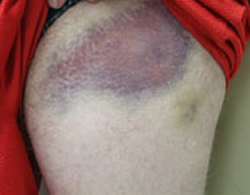|
CONTUSION A contusion is the medical term for a bruise. After trauma, patients may have many superficial contusions that are visible to the eye. Bruises are produced by bleeding into the tissues from small blood vessels. The area that has been injured will undergo an inflammatory response. This causes swelling and tenderness at the site. Contusions or bruises change color as they heal. Initially, they appear deep red. Over the first few days, the color becomes more bluish-purple. This change reflects the loss of oxygen from the hemoglobin molecules. Hemoglobin is a protein found in red blood cells that carries oxygen. When oxygen is attached to hemoglobin, the blood appears red (as arterial blood). Blood becomes darker or "blue" when the oxygen level is reduced (as the blood in the veins). As the contusion matures, the red blood cells trapped in the tissue begin to die. Red blood cells contain bilirubin. Dying blood cells will release their bilirubin. The bilirubin produces a yellowish-green appearance. Organs can also become contused. After rapid deceleration type injuries (e.g., fall, car crashes), patients can "contuse" any organ, including the brain, lung, heart and liver. The consequence of a contusion can range from minor tenderness to life-threatening bleeding and organ failure. When the brain is contused, it can swell. Swelling of the brain is a very serious complication of trauma and is called cerebral edema. |
Image 1: A contusion (bruise).
|
|
|
|
|
|
|
|
|
|
|
|
Last Updated: October 23, 2014



